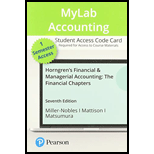
(1)
To prepare: The T-accounts for each item.
Introduction: The financial statements of a company include the
2.
Introduction:
To record: Journalizing and posting December transactions.
3.
To prepare: Adjusted
Introduction: The financial statements of a company include the balance sheet, income statement, and cash flow statement. All these statements help the internal and external users of financial statements help in analyzing and concluding the financial position of the respective company.
4.
To prepare: Single-step income statement, statement of
Introduction: The financial statements of a company include the balance sheet, income statement, and cash flow statement. All these statements help the internal and external users of financial statements help in analyzing and concluding the financial position of the respective company.
5.
To prepare: Calculation of Gross profit percentage
Introduction: Gross profit is the profit a company makes after deducting the costs associated with making and selling its products, or the costs associated with providing its services. Gross profit will appear on a company's income statement and can be calculated by subtracting the cost of goods sold (COGS) from revenue (sales).
Want to see the full answer?
Check out a sample textbook solution
Chapter 5 Solutions
Pearson eText Horngren's Financial & Managerial Accounting: The Financial Chapters -- Instant Access (Pearson+)
- I need guidance with this financial accounting problem using the right financial principles.arrow_forwardA company had expenses other than the cost of goods sold of $280,000. Determine sales and gross profit given that the cost of goods sold was $120,000 and net income was $180,000.arrow_forwardaccounting?arrow_forward
- I need assistance with this general accounting question using appropriate principles.arrow_forwardWhat is the total manufacturing cost?arrow_forwardRachel is the stockholder and operator of Grand Dream LLC, a business coaching service. At the end of its accounting period, December 31, 2017, Grand Dream has assets of $825,000 and liabilities of $192,000. Using the accounting equation, determine the following amounts: a. Stockholders' equity as of December 31, 2017. b. Stockholders' equity as of December 31, 2018, assuming that assets increased by $128,000 and liabilities decreased by $42,000 during 2018.arrow_forward
- Please explain the solution to this financial accounting problem with accurate principles.arrow_forwardPluto Manufacturing reported the following: • • Direct labor: $7,500 Direct materials used: $3,000 Manufacturing overhead: $950 Cost of goods manufactured: $22,000 Ending work-in-process inventory: $2,200 What is the beginning work-in-process inventory?arrow_forwardProvide accurate answerarrow_forward
 Financial AccountingAccountingISBN:9781337272124Author:Carl Warren, James M. Reeve, Jonathan DuchacPublisher:Cengage Learning
Financial AccountingAccountingISBN:9781337272124Author:Carl Warren, James M. Reeve, Jonathan DuchacPublisher:Cengage Learning
